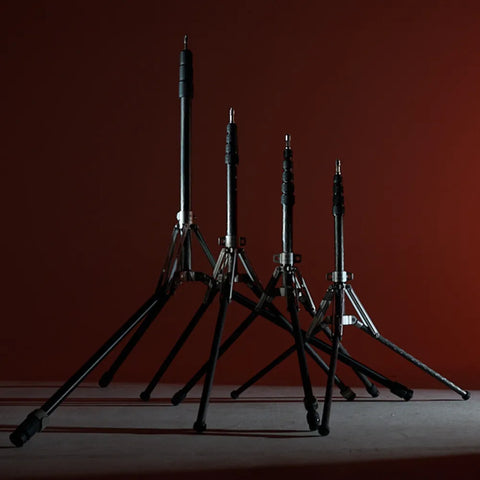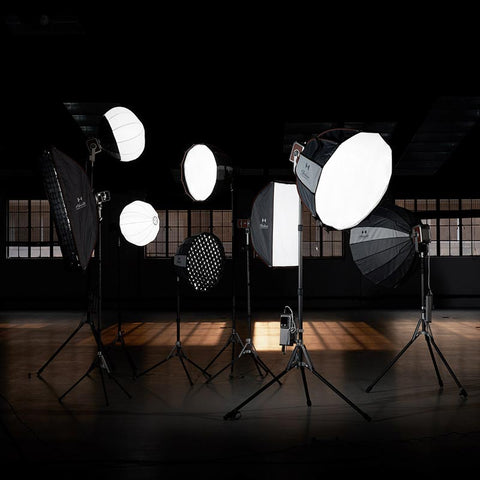Are harsh shadows messing up your portrait photos? Softboxes are the answer! They're a must-have for photographers who want to create beautiful, professional-looking pictures. Softboxes change harsh light into a soft, even light that makes your subjects look their best. Let's see how the softboxes work and find out which one could take your photography to the next level.

Why Use a Softbox? The Basics of Softer Light
Ever wonder why people look better in photos on cloudy days than in bright sunlight? It's because of soft light! Soft light gently wraps around faces instead of creating hard shadows. A softbox does the same thing inside. It diffuses light to create a softer and more even lighting effect.
Softboxes are great for:
- Lessening harsh shadows under the eyes, nose, and chin
- Making skin look smoother and more natural
- Creating soft highlights that don't wash out faces
- Making light that softens skin, hiding flaws
- Adding sparkle to the eyes, making portraits more lively
This big difference makes softboxes a must-have for portrait photographers. Natural light is great when you can get it, but softboxes let you control the light no matter the time or weather, empowering you to shape your visual story with precision.
Besides portraits, softboxes are also useful for taking pictures of products, filming interviews, and even photographing food. The controlled, even light helps show off colors and textures while still looking natural.
How a Softbox Changes Light: From Sharp to Smooth
To see how good a softbox is, think about the difference between the sun at noon and the sun in the late afternoon shining through clouds. The noon sun makes hard, dark shadows, while the afternoon sun is softer and the shadows fade more gently.
A softbox works by spreading the light. When light goes into the box, it bounces around inside off the shiny surfaces. Then it passes through one or more layers of special material. This spreads the light out over a larger area, making it softer.
The reason this works has to do with how big the light looks to the person or thing you're photographing. A plain light bulb or LED looks like a tiny point, which makes sharp shadows. A softbox makes the light seem much bigger, so the shadows are softer and fade more smoothly from light to dark.
This "wrap-around" effect is what makes softbox light so good for portraits. Instead of hitting the person from just one direction, the light seems to curve around their face, filling in shadows while still showing shape and depth.

A Quick Look at Different Types
Quick Release Softbox
If you're a photographer who's always on the move, quick release softboxes are super handy. They have a design like an umbrella that lets them pop open and lock in place in just a few seconds. No need to mess with complicated setups! Models like the Harlowe Quick Release Softbox 1x4ft (30x120cm) exemplify this perfect balance of quality and ease of use.



- Regular price
- Sale price
- $249.00

Because they're so fast to set up, they're great for shooting in different locations when you don't have much time. Most of them fold down into a small bag, so they're easy to carry around if you need to travel light. They might not give you as much control over the light as some other softboxes, but their convenience makes them a favorite for photographers who shoot events and news stories.
Lantern Softbox
Lantern softboxes are round or tube-shaped and spread light out evenly in every direction. Unlike regular softboxes that mostly shine light forward, lantern softboxes light up everything around them.
This makes them great for:
- Group photos: When you need everyone to be lit up the same way.
- Filling a room with light: To make it look naturally bright.
- Video interviews: When you want the lighting to be consistent across the whole scene.
- Times when you want soft, even light that doesn't look like it's coming from a specific direction.
A lantern softbox is a great choice when you want natural-looking light that appears unpositioned. If you're aiming for light that's less directional and more ambient, a lantern softbox lighting setup, such as those offered by Harlowe, might be right up your alley.

Foldable Softbox
Foldable softboxes are both easy to carry and useful in different situations. Unlike the quick release kind, you usually have to put these together a little bit, but they fold flat when you're not using them. Many also have removable panels to adjust the softness of the light. For a photographer needing portability and adjustable lighting, brands providing foldable softbox lighting, such as Harlowe, offer a solid middle ground.
Because they fold up, lots of photographers keep these in their gear bags. It takes a little longer to set them up than quick release softboxes, but they often give you more control over the light and last longer. If you're a photographer who travels with your equipment but doesn't need to set up in a hurry, foldable softboxes are a great middle ground.

Deep Parabolic Softbox
If you want more dramatic light that you can control precisely, deep parabolic softboxes are a great choice. They have a bowl shape that focuses the light, creating a nice fade from bright to dark.
Deep parabolic softboxes create light that:
- Is more focused than regular softboxes.
- Creates stronger bright and dark areas for a more 3D look.
- Makes the eyes sparkle.
- Gives you more control over where the light shines and how much contrast there is.
Fashion and portrait photographers often like deep parabolic softboxes because they can shape the light and make images that really stand out. They take some practice to position correctly, but they can turn regular portraits into amazing works of art.



- Regular price
- Sale price
- $299.00

| Type | Best For | Portability | Setup Speed | Light Control |
|---|---|---|---|---|
| Quick Release | Events, location shoots | High | Very Fast | Medium |
| Lantern | Group photos, ambient light | Medium | Medium | Low |
| Foldable | Travel, studio work | High | Medium | High |
| Deep Parabolic | Fashion, dramatic portraits | Low | Slow | Very High |
Choosing the Right Softbox: Size, Shape, and Connection
Choosing the Right Softbox Size
When you're picking out a softbox, the size is really important because it affects how the light looks. Usually, bigger softboxes make softer light. But you also have to think about what makes sense for your situation.
For close-up shots of faces or single people, a softbox that's about 24x36 inches or a round one that's 30 inches across is usually good enough. If you're taking pictures of people's whole bodies or small groups, you might want to get a bigger softbox, like 48 inches or more.
Keep in mind how much room you have to work with. A huge softbox won't do you any good if you can't move it around in your studio or wherever you're shooting. Also, think about whether you need to carry your softbox around a lot.
Shape Matters
Softboxes come in different shapes, and each one changes the light and the way it reflects in the eyes:
- Rectangular softboxes make light that looks like it's coming from a window
- Square softboxes create square catchlights in eyes
- Octaboxes produce round catchlights preferred by many
- Strip boxes are ideal for rim lighting and separation
- Parabolic softboxes deliver focused yet soft directional light
Pick a shape that works well with what you're shooting and the style you like. Lots of professional photographers end up getting different shapes for different situations.
Connection Considerations
Before you buy a softbox, make sure it will connect to your light. Most companies use their own ways of attaching things, but there are adapters that can make different brands work together.
Among the various connection types, the Bowens mount is the most common. Some softboxes are made for specific LED lights or constant lights. Always check to see if things will work together before you buy them, so you don't get annoyed and have to return stuff.
Your First Setup: 4 Steps for Quick Using Your Softbox
Setting up your first softbox doesn't have to be scary. Here's what you need to know to get started:
- Start by putting your softbox at a 45-degree angle to the person or thing you're photographing.
- Put it a little higher than their eyes, and point it down a bit.
- Start with the softbox fairly close, about 3-4 feet away.
- Take some pictures and see how they look, then make adjustments.
To make your portraits pop, try using a reflector opposite your softbox. It'll bounce light back into the shadows, evening out the lighting and keeping your subject from looking flat.
Experiment with the distance of your softbox. Closer up gives you softer light, but it won't spread as far. Move it further back for wider coverage, but the light will be a bit stronger.
For dramatic portraits, position your softbox to the side, almost at a right angle to the camera. This creates a painterly effect with striking triangles of light.
Get Better Photos Today with the Right Softbox
Softboxes are a photographer's best friend when it comes to lighting. Whether you're shooting portraits, products, or videos, the right softbox can give your work a polished, professional look. Start with a versatile softbox that suits your typical subjects. Then, experiment to find the techniques that work best for you. With a little practice, you'll be shaping light like a pro and capturing stunning images.







